Thursday 17 November 2016
White: T. Jefferies (116) - Black: K. Nevols (134)
A tough opponent - we had two games last year, the first of which I was fortunate to win (Game 13)and in the second I was well beaten (Game 26). I prepared myself for a gruelling battle - as it turned out to be. My strategy was not to enter a tactical conflict but to try to play slowly and positionally, see if I could get small advantages, and play on those in the ending.
1. e4 d5
Last year I had played the more aggressive 1. .. e5. This time, I am not taking chances and setting up my shell.
2. exd5 Qxd5
3. Nc3 Qa5
4. d4 Nf6
5. Be2
White chooses a quieter plan to the usual Bc4. His aim is to place the bishop on the long diagonal to exploit the forthcoming bishop move.
5. .... Bf5
6. Bf3
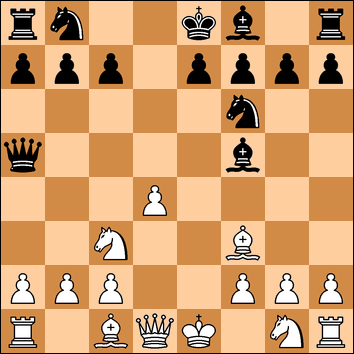
6. ..... c6
Here the computer prefers 6. .. Nc6!? The pawn to c6 is a main feature of this defence system - it solidifies the diagonal, gives the queen a route to drop back and defends the d5 square - so 6. ... Nc6 was never considered. The idea behind Nc6 is to prevent Bd2 and come to the b4 square to hit the c2 point.
After 7. Bxc6 bxc6 8. Nf3 Nd5 9. Bd2 then Black has 9. .. Nb4 10. Rc1 Nxa2 11. Ra1 Nxc3 12. Bxc3 Qd5! so 8. Bd2 Qb6 9. Bc1 Rd8!
Maybe I will give the Nc6 manoeuvre a go some time.
7. Nge2 e6
Another possibility, and idea to remember in future, is 7. .. Na6!? here, with the same idea of coming to b4. 8. Ng3 Nb4! 9. Nxf5 Qxf5 and the c2 pawn cannot be defended. (10. O-O Nxc2 11. Be4 Nxe4 12. Qxc2 Ng3!!).
8. O-O Bd6
As White has castled before I have moved the queens bishop, then playing Bb4 would have limited use - so instead I decide to prevent Bf4.
9. Ng3 Bg6
10. Re1 O-O
The king is nicely tucked away and the position is equal.
11. Nce4 Be7
12. c3
A sensible move defending the d4 point and moving off the bishop diagonal - but it surprised me. Sometimes the pawn comes to c4 - a more aggressive post but slightly weakening the pawn on d4 to which Black could consider pressure down the d-file with Rd8 etc.
12. .... Nbd7
13. Bf4
White has a keen eye on the d6 square.
13. .... Nd5
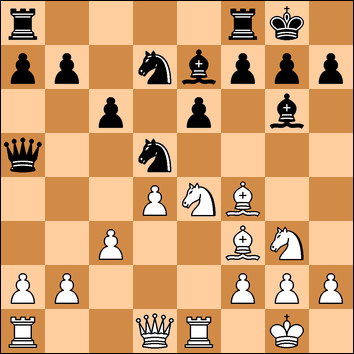
14. Bd6 Bxd6
15. Nxd6 Qc7
I was content with the exchange of the black squared bishops. Now I just need to expel the knight, and I can think of plans to bring the rooks in and move some pawns forward.
16. Bxd5?!
This surprised me. Retreating the knight to c4 or e4 may have been better. White exchanges his bishop and this gives my own white squared bishop added strength. Admittedly, with my pawns on white squares, this is only a small edge but I thought White might keep his bishop, which is well placed, and consider ideas based around c4 and d5.
I now briefly considered 16. .. Qxd6 - solely because it looked clever - but decided the bishop had to go and that I could try for some queenside initiative against the different pawn structure.
16. .... cxd5
17. Nb5 Qb6
Now against 18. Qb3 I intended 18. .. a6 19. Na3 and then perhaps 19. .. Rac8. Instead White wants to keep the queens on.
18. Qe2 a6
19. Na3 Rac8
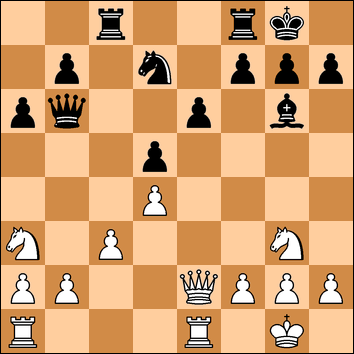
The plan! First, double up the rooks on the c-file. Second, move the queen somewhere useful. Third, advance with b5, a5, b4, and see what happens. There is not much White can do. The queen has to defend the b2 pawn, Black's centre is quite solid, and the knights have little scope.
20. Rac1 Rc6
21. Qd2 Rfc8
22. h4 h6
23. h5 Bh7
I did not mind his pawn coming to h5 - as it is just something else for White to defend.
24. Qe2 Nf6
At this point I was feeling very comfortable and thought, as long as I did not blunder, I had at least a draw in hand.
25. Nb1 Bxb1
White was pleased to see this move. The point of it is that although the bishop was controlling a number of squares, it was doing little else and is limited by my pawns in the centre. Meanwhile that knight could redeploy to d2, then f3 and finally e5 where it could prove to be a nuisance. Hence I decided to exchange it while I could.
26. Rxb1 Qc7
Preparing b5 and also thinking about attacking the h-pawn.
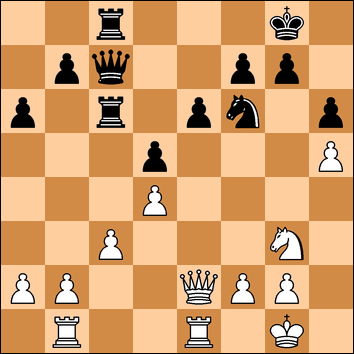
27. Qf3 Qa5
28. Ra1 Qa4
29. Qd1 Qxd1
After some thought, I decided to get the queens off. Like the bishop, I decided it had served its purpose and the absence of queens reduces any White chances of counter attacks or defences.
30. Raxd1
At this point, White offered a draw. The position is roughly equal but I thought Black had a very small edge. He has an initiative on the queenside and White has a weak pawn on h5. On the other hand, it is not easy for Black to break through - but deciding that, so long as I concentrated, then I could not lose, so I declined the offer.
30. .... Kf8
The point if this move was to defend the e-file in case it opened with f4-f5. Also, long term, to get the king to the f6 square - not possible at the moment due to the rook's pin down the e-file.
31. f3
Another surprise. I had expected 31. f4. This limits the knight and prepares a king advance.
31. .... b5
So it is now time to get on with it.
32. a3 Rc4
33. Kf2 a5
34. Re2
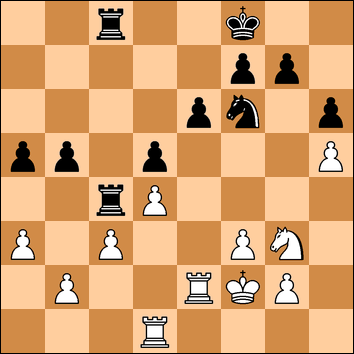
34. ..... Nd7?!
On the way to the a4 square. However, 34. ... b4 is better. 35. cxb4 axb4 36. axb4 Rxb4 37. Red2 Rcb8 38. Rb1 and then Black can choose between 38. .. Ke7 or 38. .. Rb3. Black's inaccuracy frees the white knight.
35. Nf1
Now, no longer necessary to defend the h-pawn, White has got time to bring the knight across to the defence of the queenside.
35. .... R4c6
36. Nd2 Ke7
37. g4 Kf6
The delay in playing b4 has allowed White to improve his defences. Now White could play Nb3 and disrupt the Black initiative.
38. Kg3 b4
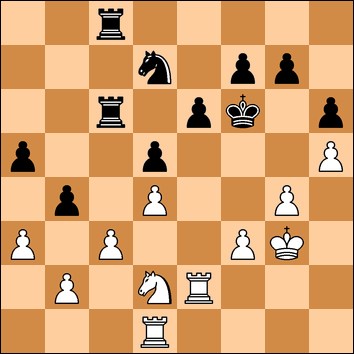
At last, but maybe too late. The white knight is better placed on d2 than it was on g3, and Black's knight is just looking on. However Black is helped by the fact that White's king has moved further away.
39. axb4 axb4
40. Nb1
I was thinking about 40. cxb4 Rc2 but then realised that this does not threaten Rxb2 because of the tactic Ne4+. So probably 40. cxb4 Rb6. The text presumably intends to reply to 40. ... bxc3 with 41. Nxc3.
40. .... Rb8
Now 41. cxb4 Rxb4 42. Nc3 is possible. Black could then try 42. ... Rcb6 43. Rdd2 and perhaps 43. ... Nb8 to relocate the knight to an aggressive position.
41. Rd3 Rcb6
42. cxb4 Rxb4
43. R3d2 Nb6
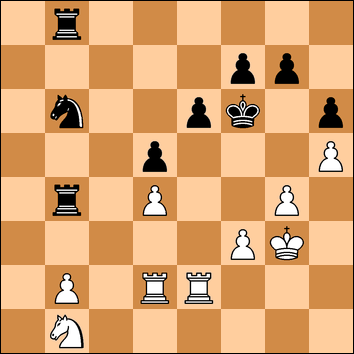
A good punch. After all the moving about, I could now see that the b-pawn was heading my way.
44. Na3 Na4
45. f4
I had to keep an eye out for any plans with Kh4, g5 and h6. Hence my rejection of 45. .. Rb3+ here.
45. .... Rxb2
Booty gathered. Now a pawn up - the next task was to win the game.
I studied to see if exchanging all the rooks and leaving a knight ending would help. Black is better placed and the target would be the white pawn on d4 as well as the advanced pawns on the kingside. I was not sure if it was clearly won.
46. g5+? Ke7?
46. ... Kf5???? of course walks into 47. Re5 mate but I really cannot explain how I missed 46. .. hxg5. You spend so much effort winning a pawn on one side of the board that you miss one which is gifted to you on the other side.
Now best for White would be 47. gxh6 - splitting Black's pawns would give some counterplay chances in the ending.
But by now the game was into its fourth hour, everyone else had gone home, the room was empty, and we were both tired. With this in mind, it was perhaps inevitable that one of us would blunder and, fortunately for me, it was White who did so first.
47. Nc2?? Nc3
48. Re3 Ne4+
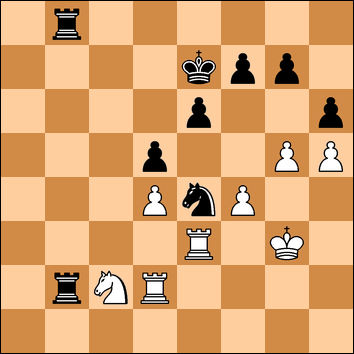
With the loss of the exchange, White decided to resign.
I was very pleased with this victory which at the time I thought was my best game so far this season. It was also my seventh unbeaten game in a row and, with five wins, one draw and one loss, put me at the top of the chess club tournament board.
No comments:
Post a Comment